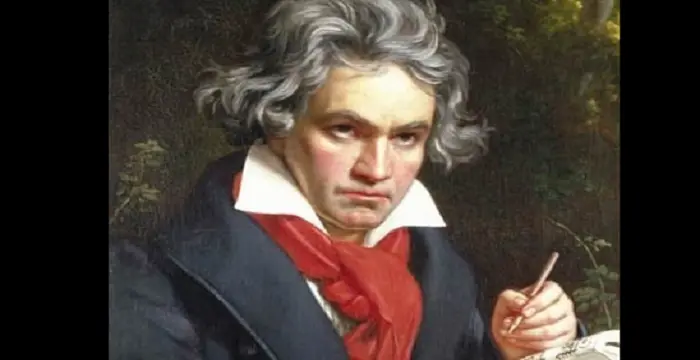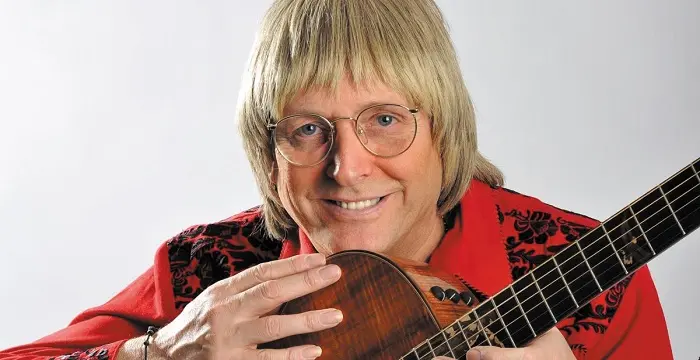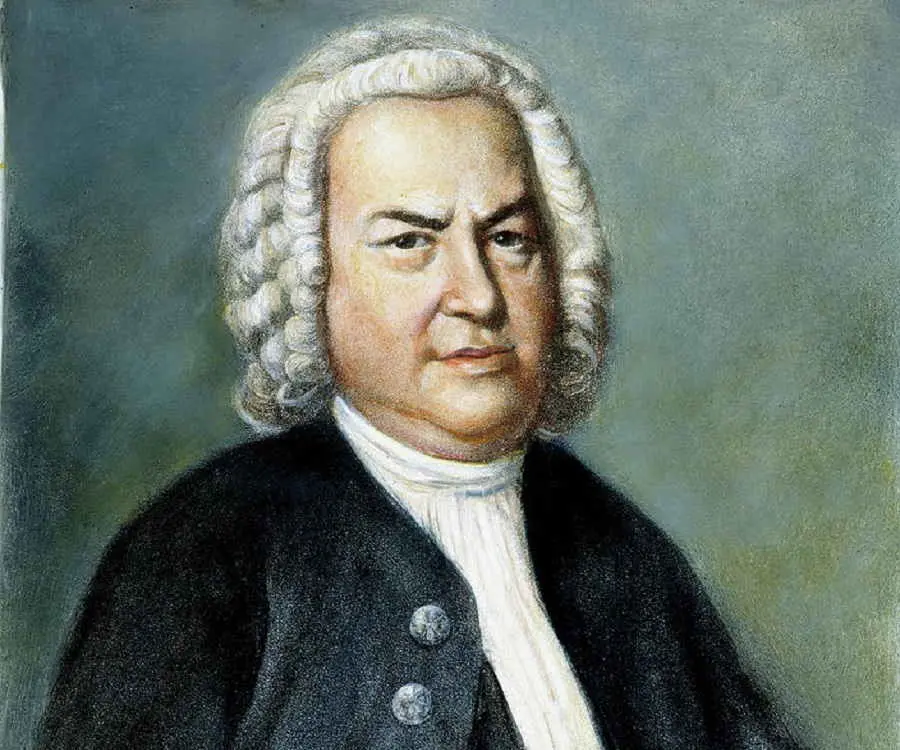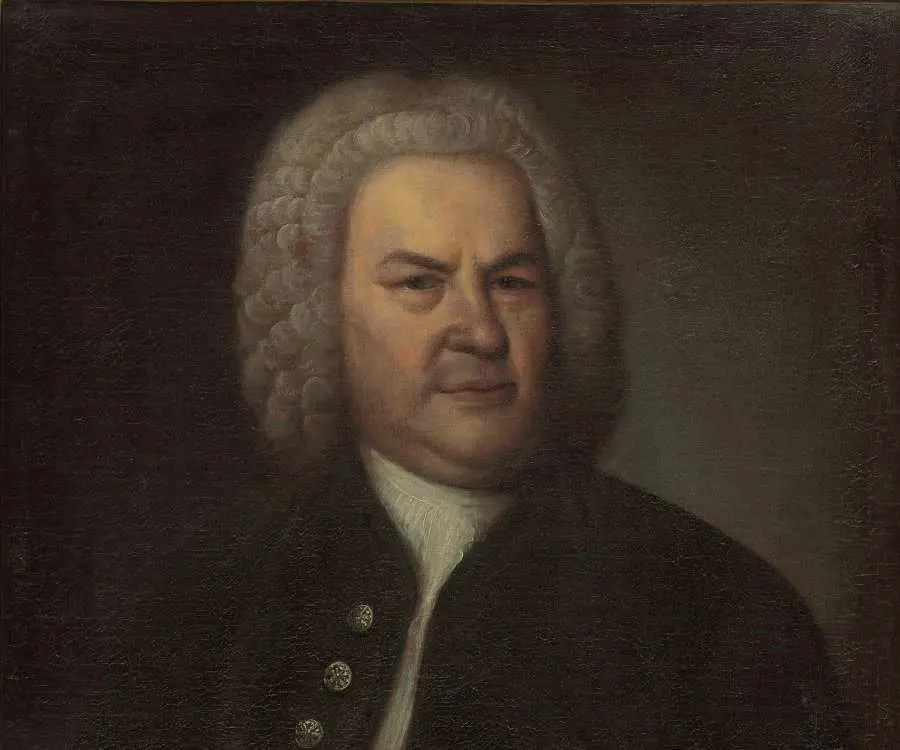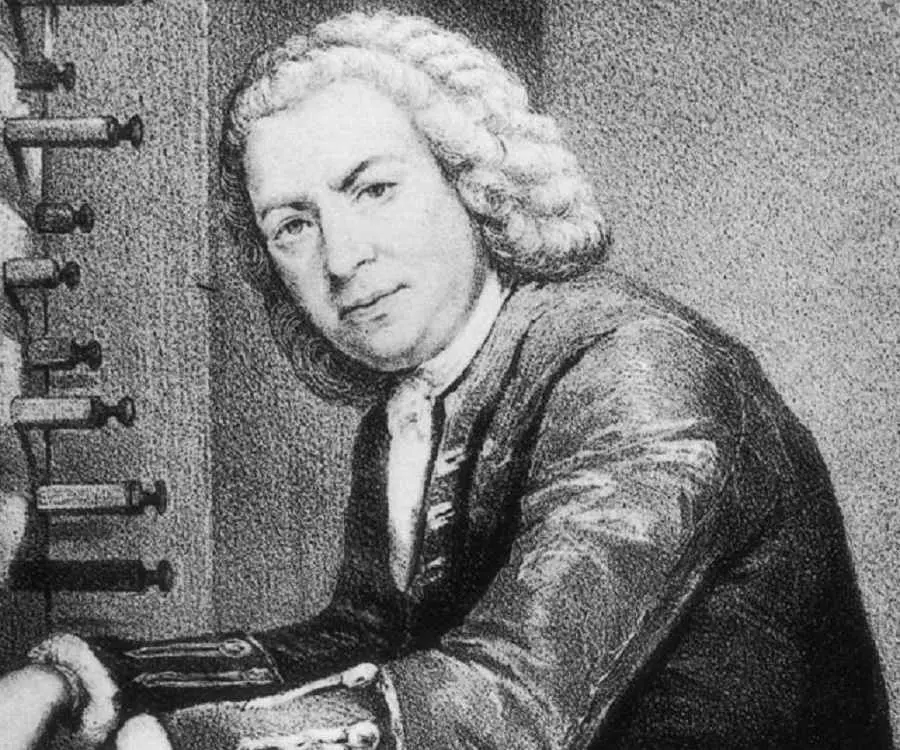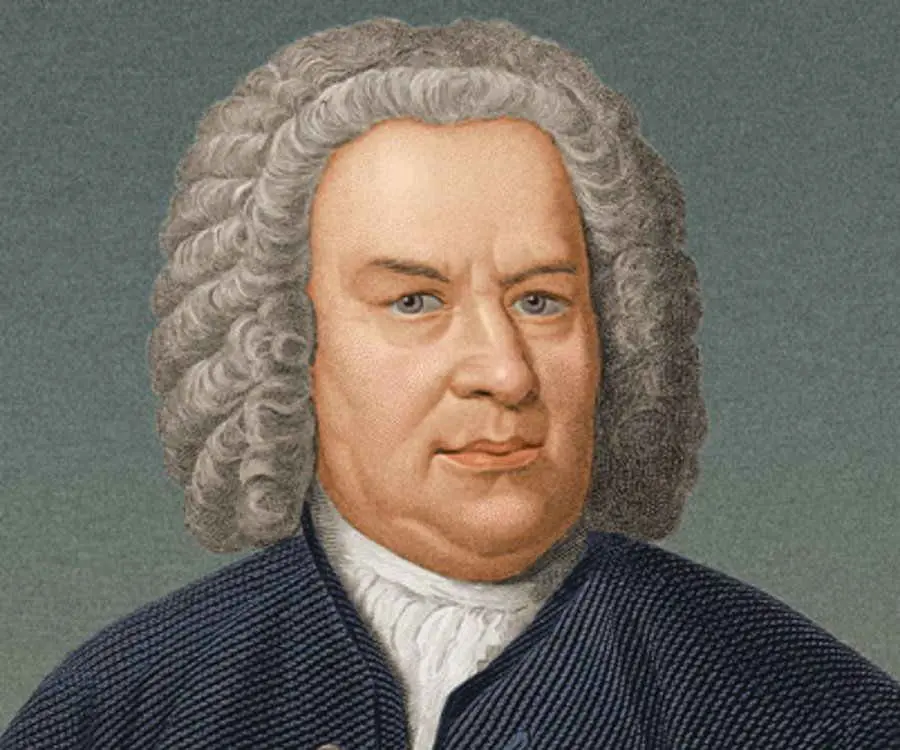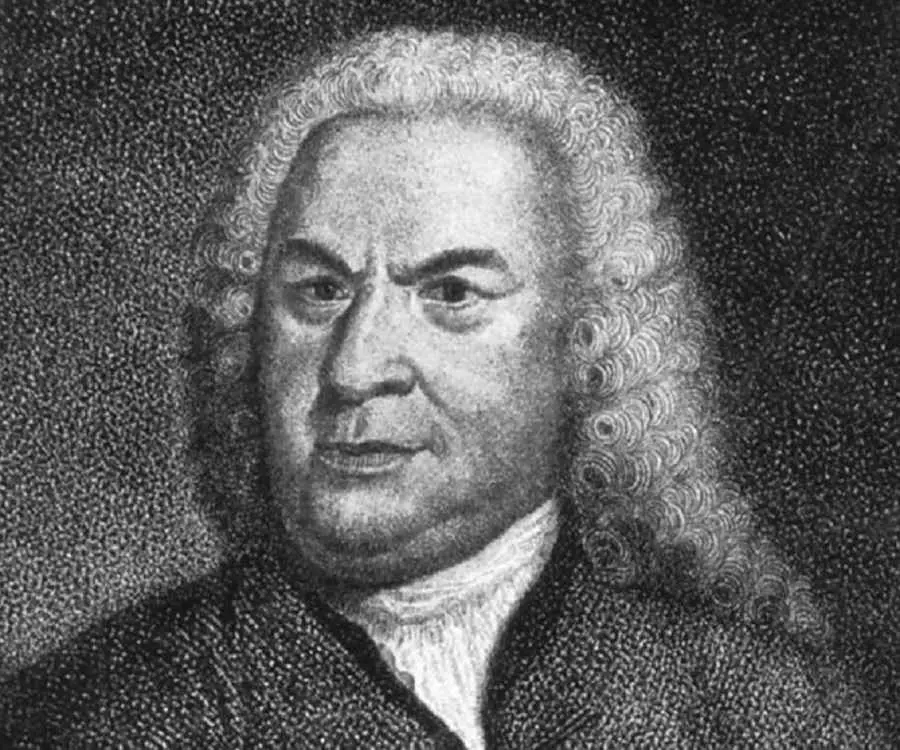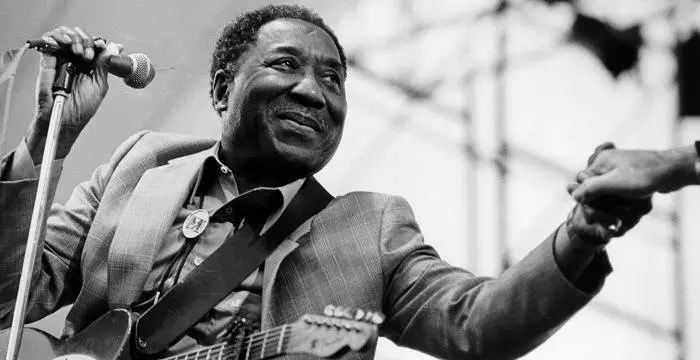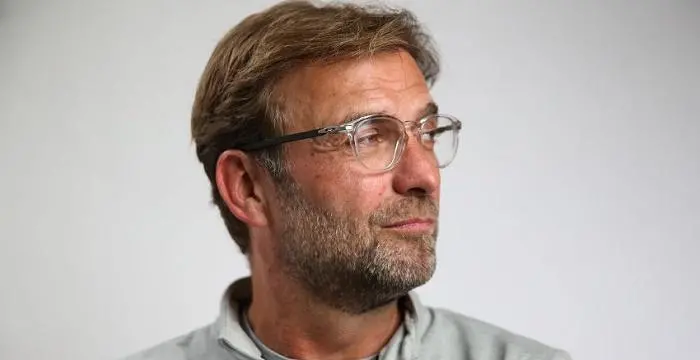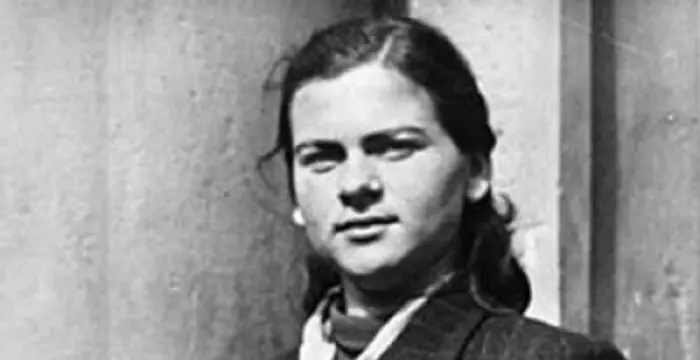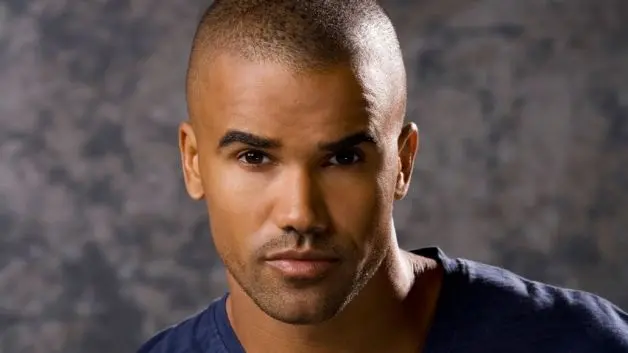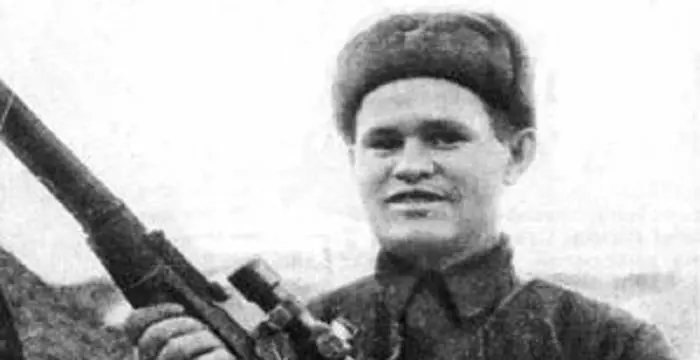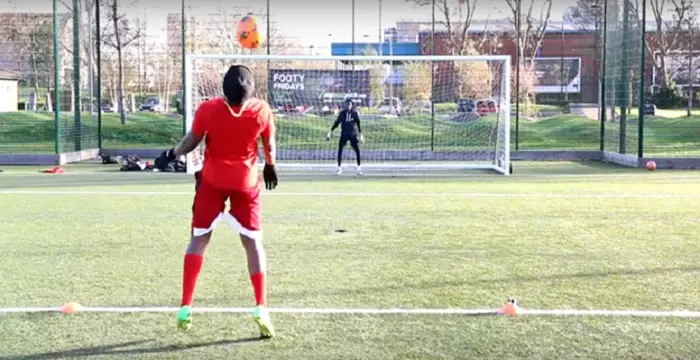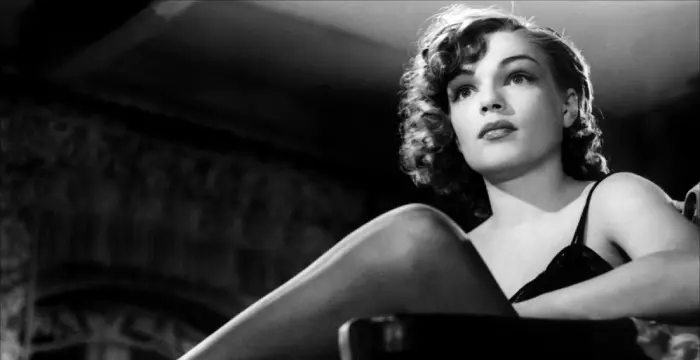
Johann Sebastian Bach - Composers, Facts and Life
Johann Sebastian Bach's Personal Details
Johann Sebastian Bach was a great German composer
| Information | Detail |
|---|---|
| Birthday | March 31, 1685 |
| Died on | July 28, 1750 |
| Nationality | German |
| Famous | Musicians, Composers |
| Spouses | Anna Magdalena Bach (m. 1721–1750), Maria Barbara Bach (m. 1707–1720) |
| Siblings | Johann Balthasar Bach, Johann Christoph Bach, Johann Jacob Bach |
| Childrens | Carl Philipp Emanuel Bach, Catharina Dorothea Bach, Christian Gottlieb, Christiana Benedicta Louise, Christiana Dorothea, Christina Sophia Henrietta, Elisabeth Juliana Friederika, Ernestus Andreas, Gottfried Heinrich Bach, Johann August Abraham, Johann Christian Bach, Johann Christoph, Johann Christoph Friedrich Bach, Johann Gottfried Bernhard Bach, Johanna Carolina, Leopold Augustus, Maria Sophia, Regina Johanna, Regina Susanna, Wilhelm Friedemann Bach |
| Universities |
|
| Birth Place | Eisenach, Saxe-Eisenach |
| Religion | Christian |
| Gender | Male |
| Father | Johann Ambrosius Bach |
| Mother | Maria Elisabetha Lämmerhirt |
| Sun Sign | Aries |
| Born in | Eisenach, Saxe-Eisenach |
| Famous as | Composer |
| Died at Age | 65 |
// Famous Composers
Ludwig van Beethoven
Ludwig Van Beethoven was one of the greatest composers the world has ever had. Check out this biography to know about his childhood, family life, and achievements.
Emina Jahović
Emina Jahović Sandal is a Serbian model, actress and singer-songwriter. Know more about her childhood, life, career, achievements and timeline in this biography.
John Denver
John Denver, a famous American singer-songwriter and activist, is remembered for songs like Take Me Home, Country Roads and Annie's Song. To know more about his childhood, career, profile and timeline read on
Johann Sebastian Bach's photo
Who is Johann Sebastian Bach?
Johann Sebastian Bach was a German composer, born in late seventeen century into a reputed musical family at Eisenach, Germany. He had his early musical training under his father and uncle. He lost both his parents at a young age following which his eldest brother took him into his household and began tutoring him. At fifteen, he was sent to Michaelis monastery at Lüneburg, where he completed his training. Bach began his career as a violinist in Weimar and then shifted to Arstadt as an organist. From there, he went to Mühlhausen and then again to the Court of Weimar, and subsequently to Köthen before settling at Leipzig. However, in most places, his employers were unsympathetic to his aspirations or talent and therefore he did not get either money or fame in his lifetime. His music was rediscovered about fifty years after his death; by then many of his creations had been lost. Today he is considered as one of the greatest composers of all time.
// Famous Musicians
Ted Nugent
Ted Nugent is a hard rock musician known for his hits ‘Stranglehold’ and ‘Cat Scratch Fever’. This biography of Ted Nugent provides detailed information about his childhood, life, achievements, works & timeline.
Muddy Waters
Muddy Waters was a blues musician referred to as the 'father of modern Chicago blues.' Check out this biography to know about his childhood, family life, achievements and fun facts about him.
Travis Bacon
Travis Bacon is an American musician and actor, better known as the son of veteran actors Kevin Bacon and Kyra Sedgwick. Find more about his family, birthday, etc.
Childhood & Early Life
Johann Sebastian Bach was born on 31 March 1685, in Eisenach, the capital city of the duchy of Saxe-Eisenach. His father, Johann Ambrosius Bach, was the court trumpeter for the Duke of Eisenach and director of the town musicians. His mother, Maria Elisabeth Lämmerhirt, was the daughter of a furrier.
Sebastian, the youngest of his parents’ eight children, grew up in a musical environment. All his parental uncles as well as four of his own brothers were renowned musicians. While his father taught him violin and the harpsichord, his uncle, Johann Christoph Bach, gave him lessons in organ.
At the age of eight, young Sebastian started going to the local Latin Grammar School, where, apart from reading and writing, he also studied scriptures in Latin and German. Later as the students formed the choir of the St. Georgenkirche, he was selected as one of the choirboys.
Sebastian’s mother died on 1 May, 1694. His father too passed away on 2 March 1695. Thus he became an orphan shortly before his tenth birthday.
In Ohrdruf & Lüneburg
By then, his eldest brother, also named Johann Christoph Bach, had established himself as organist at the St. Michaeliskirche, Ohrdruf. He now took charge of his two youngest brothers, ten year old Johann Sebastian Bach and thirteen year old Johann Jacob Bach.
Thus in 1695, at the age of ten, Sebastian began to live in the household of his brother in Ohrdruf, happily taking lessons in organ and harpsichord from him. The elder Bach also encouraged him to copy music of renowned musicians of that time and watch how organs were constructed.
Simultaneously, he also attended the Gymnasium in Ohrdruf, where he had lessons in Latin, Greek, French, Italian and theology. During his period, he sang in the local choir. His soprano voice and musical capabilities soon impressed the Cantor Elias Herda.
Sometime in early 1700, he found a place in the choir of the wealthy Michaelis monastery at Lüneburg, possibly at the recommendation of Elias Herda, who himself was a student there. There, he was immediately appointed to Mettenchor, a select body of singers, because of his uncommonly beautiful soprano voice.
Subsequently, he started participating in different types of choral or orchestral performances. He was also free to use the fine music library in the monastery, thus enriching his knowledge on the subject. Later, as his voice began to change, he started acting as the violinist and also as an accompanist at the harpsichord.
During this period, he met Georg Böhm, a noted organist, who introduced Bach to the great organ tradition of Hamburg. Later he managed to visit Hamburg to hear the renowned organist and composer Johann Adam Reinken.
Sometime now, he went to play violin at the Court of Count of Celle and there he heard French instrumental music. Thus by late summer of 1702, when he left Lüneburg, he had not only become proficient as an organist, but had also experienced varied types of music.
In Weimar
Johann Sebastian Bach first tried for employment at the new church of Arnstadt in his native Thuringia. Unfortunately, there the organ was still under construction and while waiting for the work to finish, he received an offer from Johann Ernst, the Duke of Weimar.
Subsequently, he began his career as a violinist in the small chamber orchestra of Johann Ernst at Weimar. Concurrently, he acted as deputy to the Court Organist, Effler and soon came into contact with Italian instrumental music.
In Arstadt & Mühlhausen
In July 1703, Bach was offered the post of the organist by the Arnstadt Town Council on a generous term. He therefore left Weimar and happily started on his new job sometime in August.
In October 1705, he managed to get leave to visit Lübeck, where he visited the great organist, Dietrich Buxtehude. There he not only had great discussions with the master, but also attended several concerts. Thus he extended his stay, without leave, until February 1606.
On his return, he tried to use his newly acquired skills in his new compositions—something the choir could not follow, resulting in utter confusion. The church authority decided to reprimand him for those ‘strange sounds’ and also for his absence without leave.
The matters came to a head when citing a clause in his contract he refused to train the choir boys. He started looking for other opportunities and when in 1706, he heard that the organist to the town of Mühlhausen had died, he applied for the post.
Thereafter in June 1707, he took up his new post at the Blasius Church in Mühlhausen. Very soon, a conflict arose between the orthodox Lutherans and the Pietists. With rise of the latter, the state of music became uncertain at Mühlhausen.
Therefore, when Duke of Weimar offered him the post of chamber musician at his Court on a generous term, he gladly took it up. He sent in his letter of resignation to the authorities on June 25, 1708 and left for Weimar.
Return to Weimar
At Weimar, Bach, who was both a member of the chamber orchestra and an Organist to the Court, had the opportunity to work with a large contingent of professional musicians for the first time. He soon started composing keyboard and orchestral work on regular basis.
It was here in Weimar that he began to induct foreign influences into the existing German music successfully. Many of his famous works were composed here and his fame began to spread. Among his well-known works of this period was ‘Orgelbüchlein’ (Little Organ Book).
Sometime late in 1713, Bach was asked to succeed Friedrich Wilhelm Zachow at the Liebfrauenkirche, Halle. However, the Duke of Weimar raised his salary and so he stayed back.
On 2 March 1714, he became Konzertmeister (director of music) at the ducal court and started performing a church cantata monthly in the castle church. He was now second only to Capellmeister Johann Samuel Drese, who was old and frail. Subsequently, he started taking over the duties of the older musician.
In 1717, a conflict arose in the Court of Weimar and Bach was unfortunately drawn into it. On the order of the Duke of Weimar, he was imprisoned for one month. On his release, he left Weimar and moved to Köthen, some thirty miles north of Halle.
In Köthen
At Köthen, Johann Sebastian Bach became the Capellmeister in the Court of young prince Leopold of Anhalt-Cöthen. Life there was informal and smooth. He therefore was able to concentrate on his music, writing much of his chamber music—violin concertos, sonatas, and keyboard music—during this period.
Sometime in late 1721, Bach’s master Prince Leopold got married. Unfortunately, his wife was not at all musically inclined and what is more, she tried to wean away the Prince from music. Moreover, Bach’s children were growing up and there was no good educational facility at Köthen. Therefore, Bach once more decided to move.
In Leipzig
In 1723, Bach was appointed Thomaskantor, Cantor of the Thomasschule at the Thomaskirche in Leipzig. He reached the town on May 22, 1723 and his first official performance was on May 30.
In this capacity, he was required to supply music for four churches and therefore these years were essentially very productive. It is believed in the first three years, he produced one new cantata every week, which not only met the present need, but also took care of the future requirements.
In March 1729, he took up the directorship of the Collegium Musicum, a secular ensemble, consisting of mainly college students. He now began to compose music suitable for it and continued doing so even after he gave up the post in 1737.
Meanwhile in 1733, Bach was appointed the Court composer at Leipzig. Later he also received honorary appointments at the Courts of Köthen and Weissenfels as well as in the Court of Frederick Augustus (also the King of Poland) in Dresden.
In 1747, Bach joined the Correspondierende Societät der musikalischen Wissenschafften (Corresponding Society of the Musical Sciences) of Lorenz Christoph Mizler von Kolof. However, from 1749, his health began to decline and his eyesight also became dim. His last large work, ‘Mass in B minor’ was composed sometime in 1748–49.
Major Works
In his long career, Johann Sebastian Bach created a large body of music. Among them, his ‘Brandenburg Concertos’, composed by 1721, is believed to be one of the best orchestral compositions of the Baroque era.
’The Goldberg Variations, BWV 988’ is another of his major works. Named after Johann Gottlieb Goldberg, the work was first published in 1741. It is considered to be one of the most important examples of variation form.
Personal Life & Legacy
On 17 October 1707, four months after arriving at Mühlhausen, Bach married his second cousin Maria Barbara Bach. Together they had seven children, four of who reached adulthood.
His surviving children from this marriage were Catharina Dorothea, Wilhelm Friedemann, Carl Philipp Emanuel and Johann Gottfried Bernhard. They were all born in Weimar. Maria died all of a sudden on 7 July, 1720.
In 1721, Bach met Anna Magdalena Wilcke, a highly gifted singer at the Court in Köthen. They married on 3 December 1721 and together had thirteen children. However, only six of them survived.
Bach’s surviving children from his second marriage were Gottfried Heinrich, Elisabeth Juliane Friederica, Johann Christoph Friedrich, Johann Christian, Johanna Carolina and Regina Susanna. Many of his children, from both the marriages, later became accomplished musicians.
Bach’s eyesight began to suffer from the middle of 1749. Subsequently, he had his eyes operated upon by John Taylor, first in March 1750 and then again in April 1750. Eventually he died on 28 July 1750 as a consequence of these unsuccessful operations, at the age of 65.
In his lifetime, Bach received little appreciation; nor was he adequately paid. While for 150 years, he lay in an unmarked grave, his legacy too remained forgotten until the beginning of the nineteenth century. Today, he is remembered as one of the greatest composers of all time.
Trivia
At the time of his death, Bach’s estate consisted of great many musical instruments and fifty-two religious books. There was no or little money. When his wife died ten years later, she was given a pauper’s funeral.
// Famous German peoples
Jordan Carver
Jordan Carver is a famous German model. Let’s take a close look at her personal life, including her age, career, net worth, achievements and some fun facts.
Jürgen Klopp
Jürgen Klopp is a German football manager, and a former professional football player. Check out this biography to know more about his childhood, family, personal life, etc.
Irma Grese
Irma Grese was a notorious German Nazi concentration camp guard during the Second World War. This biography profiles her childhood, life, horrifying acts, death and other facts.
Johann Sebastian Bach biography timelines
- // 1605 To 1705In October 1705, he managed to get leave to visit Lübeck, where he visited the great organist, Dietrich Buxtehude. There he not only had great discussions with the master, but also attended several concerts. Thus he extended his stay, without leave, until February 1606.
- // 31st Mar 1685Johann Sebastian Bach was born on 31 March 1685, in Eisenach, the capital city of the duchy of Saxe-Eisenach. His father, Johann Ambrosius Bach, was the court trumpeter for the Duke of Eisenach and director of the town musicians. His mother, Maria Elisabeth Lämmerhirt, was the daughter of a furrier.
- // 1st May 1694Sebastian’s mother died on 1 May, 1694. His father too passed away on 2 March 1695. Thus he became an orphan shortly before his tenth birthday.
- // 1695Thus in 1695, at the age of ten, Sebastian began to live in the household of his brother in Ohrdruf, happily taking lessons in organ and harpsichord from him. The elder Bach also encouraged him to copy music of renowned musicians of that time and watch how organs were constructed.
- // 1700Sometime in early 1700, he found a place in the choir of the wealthy Michaelis monastery at Lüneburg, possibly at the recommendation of Elias Herda, who himself was a student there. There, he was immediately appointed to Mettenchor, a select body of singers, because of his uncommonly beautiful soprano voice.
- // 1st Jul 1703In July 1703, Bach was offered the post of the organist by the Arnstadt Town Council on a generous term. He therefore left Weimar and happily started on his new job sometime in August.
- // 1707Thereafter in June 1707, he took up his new post at the Blasius Church in Mühlhausen. Very soon, a conflict arose between the orthodox Lutherans and the Pietists. With rise of the latter, the state of music became uncertain at Mühlhausen.
- // 17th Oct 1707On 17 October 1707, four months after arriving at Mühlhausen, Bach married his second cousin Maria Barbara Bach. Together they had seven children, four of who reached adulthood.
- // 1713Sometime late in 1713, Bach was asked to succeed Friedrich Wilhelm Zachow at the Liebfrauenkirche, Halle. However, the Duke of Weimar raised his salary and so he stayed back.
- // 2nd Mar 1714On 2 March 1714, he became Konzertmeister (director of music) at the ducal court and started performing a church cantata monthly in the castle church. He was now second only to Capellmeister Johann Samuel Drese, who was old and frail. Subsequently, he started taking over the duties of the older musician.
- // 1717In 1717, a conflict arose in the Court of Weimar and Bach was unfortunately drawn into it. On the order of the Duke of Weimar, he was imprisoned for one month. On his release, he left Weimar and moved to Köthen, some thirty miles north of Halle.
- // 7th Jul 1720His surviving children from this marriage were Catharina Dorothea, Wilhelm Friedemann, Carl Philipp Emanuel and Johann Gottfried Bernhard. They were all born in Weimar. Maria died all of a sudden on 7 July, 1720.
- // 1721Sometime in late 1721, Bach’s master Prince Leopold got married. Unfortunately, his wife was not at all musically inclined and what is more, she tried to wean away the Prince from music. Moreover, Bach’s children were growing up and there was no good educational facility at Köthen. Therefore, Bach once more decided to move.
- // 1721In his long career, Johann Sebastian Bach created a large body of music. Among them, his ‘Brandenburg Concertos’, composed by 1721, is believed to be one of the best orchestral compositions of the Baroque era.
- // 1721In 1721, Bach met Anna Magdalena Wilcke, a highly gifted singer at the Court in Köthen. They married on 3 December 1721 and together had thirteen children. However, only six of them survived.
- // 1723In 1723, Bach was appointed Thomaskantor, Cantor of the Thomasschule at the Thomaskirche in Leipzig. He reached the town on May 22, 1723 and his first official performance was on May 30.
- // 1729In March 1729, he took up the directorship of the Collegium Musicum, a secular ensemble, consisting of mainly college students. He now began to compose music suitable for it and continued doing so even after he gave up the post in 1737.
- // 1733Meanwhile in 1733, Bach was appointed the Court composer at Leipzig. Later he also received honorary appointments at the Courts of Köthen and Weissenfels as well as in the Court of Frederick Augustus (also the King of Poland) in Dresden.
- // 1747In 1747, Bach joined the Correspondierende Societät der musikalischen Wissenschafften (Corresponding Society of the Musical Sciences) of Lorenz Christoph Mizler von Kolof. However, from 1749, his health began to decline and his eyesight also became dim. His last large work, ‘Mass in B minor’ was composed sometime in 1748–49.
- // 28th Jul 1750Bach’s eyesight began to suffer from the middle of 1749. Subsequently, he had his eyes operated upon by John Taylor, first in March 1750 and then again in April 1750. Eventually he died on 28 July 1750 as a consequence of these unsuccessful operations, at the age of 65.
// Famous Aries Celebrities peoples
Skai Jackson
Skai Jackson is an American child actress with huge fan following. Find more about her family & personal life, relationships, facts and more.
Shemar Moore
Shemar Moore is a model turned actor best known for his role in the television series ‘The Young and the Restless’. This biography of Shemar Moore provides detailed information about his childhood, life, achievements, works & timeline.
Vasily Zaytsev
Vasily Zatysev was a Russian sniper who served during the World War II. Check out this biography to know about his childhood, family life, achievements and fun facts about him.
Ivey Meeks
Ivey Meeks is an American YouTube star and model. Let’s have a look at her family and personal life including age, date of birth, net worth, boyfriends and fun facts.
Tobi Lerone
Check out all that you wanted to know about Tobi Lerone, the famous YouTube Personality and gamer; his birthday, his family and personal life, his girlfriends, fun trivia facts and more.
Simone Signoret
Simone Signoret was a French actress who became the first French person to win an Academy Award. Check out this biography to know about her childhood, family life, achievements and other facts related to her life.
Johann Sebastian Bach's FAQ
What is Johann Sebastian Bach birthday?
Johann Sebastian Bach was born at 1685-03-31
When was Johann Sebastian Bach died?
Johann Sebastian Bach was died at 1750-07-28
Where was Johann Sebastian Bach died?
Johann Sebastian Bach was died in Leipzig
Which age was Johann Sebastian Bach died?
Johann Sebastian Bach was died at age 65
Where is Johann Sebastian Bach's birth place?
Johann Sebastian Bach was born in Eisenach, Saxe-Eisenach
What is Johann Sebastian Bach nationalities?
Johann Sebastian Bach's nationalities is German
Who is Johann Sebastian Bach spouses?
Johann Sebastian Bach's spouses is Anna Magdalena Bach (m. 1721–1750), Maria Barbara Bach (m. 1707–1720)
Who is Johann Sebastian Bach siblings?
Johann Sebastian Bach's siblings is Johann Balthasar Bach, Johann Christoph Bach, Johann Jacob Bach
Who is Johann Sebastian Bach childrens?
Johann Sebastian Bach's childrens is Carl Philipp Emanuel Bach, Catharina Dorothea Bach, Christian Gottlieb, Christiana Benedicta Louise, Christiana Dorothea, Christina Sophia Henrietta, Elisabeth Juliana Friederika, Ernestus Andreas, Gottfried Heinrich Bach, Johann August Abraham, Johann Christian Bach, Johann Christoph, Johann Christoph Friedrich Bach, Johann Gottfried Bernhard Bach, Johanna Carolina, Leopold Augustus, Maria Sophia, Regina Johanna, Regina Susanna, Wilhelm Friedemann Bach
What was Johann Sebastian Bach universities?
Johann Sebastian Bach studied at St. Michael's School
What is Johann Sebastian Bach's religion?
Johann Sebastian Bach's religion is Christian
Who is Johann Sebastian Bach's father?
Johann Sebastian Bach's father is Johann Ambrosius Bach
Who is Johann Sebastian Bach's mother?
Johann Sebastian Bach's mother is Maria Elisabetha Lämmerhirt
What is Johann Sebastian Bach's sun sign?
Johann Sebastian Bach is Aries
How famous is Johann Sebastian Bach?
Johann Sebastian Bach is famouse as Composer
